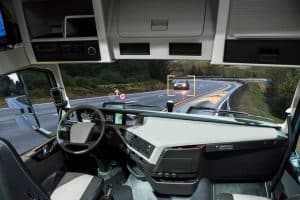Autonomous Trucks Are Here. Are We Really Ready?
 Recently, the New York Times reported an 18-wheeler truck trekked more than 6,300 miles straight and delivered eight loads of freight after making four trips. Normally, a trip like this would need multiple stops, because a driver is only allowed to drive so many hours in a row before being required to take breaks for sleep.
Recently, the New York Times reported an 18-wheeler truck trekked more than 6,300 miles straight and delivered eight loads of freight after making four trips. Normally, a trip like this would need multiple stops, because a driver is only allowed to drive so many hours in a row before being required to take breaks for sleep.
What makes this trip even more amazing is that the truck did not actually have anyone operating it. Truckers are notorious for driving while fatigued because of their inconsistent work schedules—and that creates hazardous roads. Studies show that you are three times more likely to crash while driving fatigued, and the scary statistics do not stop there.
The National Safety Council also reports that driving after losing even two hours of sleep overnight creates an effect similar to driving after having three beers. If drivers are awake for longer than 20 hours straight, the effects are similar to being legally drunk behind the wheel. Because of these horrifying statistics, it makes sense why fleets are looking into autonomous trucks. It should make our lives easier and roads safer by eliminating hundreds if not thousands of fatigued drivers. But is that really the case?
Self-driving trucks may not be so reliable
The New York Times interviewed Alex Rodrigues, chief executive of a self-driving truck company, who said he does not think these automated 18-wheelers are ready for all types of roads just yet. He mentions that they will strictly drive only on highways since everyone is traveling in the same direction without traffic lights, making them a little more reliable to make the right moves. However, if a truck is not deemed capable of driving on city streets because of oncoming traffic and changing traffic lights, what’s making them capable of safely driving on a highway at a higher speed?
Imagine that a car is traveling a few miles ahead of an autonomous truck on the highway when their tire blows out. A trucker manually operating the vehicle would see this and do their best to maneuver around the situation to avoid a direct crash. However, will a self-driving truck know what to do? A truck this heavy could cause a lot of damage and serious injuries to those in passenger cars.
AV technology could lead to less experienced truckers on the road
Despite autonomous trucks not needing anyone behind the wheel, the overall logistics would require some sort of manual truck driver towards the end of the delivery. Since self-driving trucks are not yet deemed reliable enough to operate through busier city streets, Kodiak’s autonomous trucks drove on the outskirts of a city before stopping at a “transfer hub.” Human drivers would then pick up the freight, drive it through the city, and drop it at its final destination. Per the New York Times, Kodiak recently teamed up Pilot, a company which operates more than 800 rest stops around the country; Kodiak hopes that these Pilot rest stops can serve as transfer hubs.
This seems like a practical solution, but the reality is that most truck drivers enter these careers because of the high salaries they pay—and those high salaries are typically based on the amount of miles driven. By severely cutting the distance drivers go, companies are also cutting their pay. A recent study verifies this by acknowledging that by having autonomous trucks and “transfer hubs,” up to 300,000 jobs could be affected. Many truck drivers who have been doing this for years may not be able to make ends meet on the new salary and seek other employment. This could ultimately lead to an influx of new—and less experienced—truck drivers on well-traveled city roads.
Washington, DC has strict regulations for testing autonomous vehicles
Currently, people cannot test out self-driving cars on the roads of Washington, DC on a whim. There are very strict and specific regulations in place before this can happen. The code §50–2352.01. Autonomous Vehicle Testing Program features regulations for these cars, like:
- Notating the make, model, and plate number of the vehicle
- Determining the permit length
- Assessing safety and risk mitigation
- Capability of complying with all traffic laws
- Ensuring there is a remote or physically present test operator
- Only driving the vehicle without a test operator after successfully driving with one
But no system is foolproof—accidents happen
Regardless of how in-depth Washington DC’s, or any other state’s, autonomous vehicle regulations are, accidents will still happen. And they could cause more severe injuries because there is no one fully paying attention to the road or helping take control if needed. In fact, there have been almost a dozen deaths as a result of cars using automated driving systems recently.
One common theme is that cars with advanced driver assist technology activated do not recognize people riding on motorcycles. This leads to a crash, which can often be fatal for the motorcycle driver since they are not as protected as someone inside of a car. And if the car’s operator did not take manual control of the car in time, there may not have even been an attempt to swerve or stop.
If you were injured by a self-driving truck, you should seek the help of an experienced truck accident attorney. When it comes to dealing with accidents involving autonomous vehicles, liability may be difficult to determine. Depending on the exact details, the operator can still be held liable or it can be the manufacturer. It is best to work with an experienced attorney to help navigate the best way forward. While the overall number of people hurt or killed by autonomous vehicles is small, these people are never insignificant.
Please contact Paulson & Nace, PLLC through our contact form or by calling our offices today.

Christopher T. Nace works in all practice areas of the firm, including medical malpractice, birth injury, drug and product liability, motor vehicle accidents, wrongful death, and other negligence and personal injury matters.
Read more about Christopher T. Nace.
